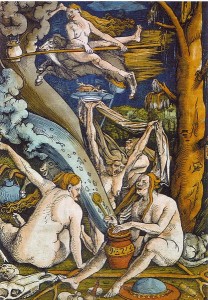Halloween wasn’t always a children’s holiday. It wasn’t about dressing up in funny clothes, wearing masks and/or heavy makeup, and hitting your neighbors up for candy. And it definitely wasn’t fun.
All Hallows Eve was a very serious night when the souls of the dead returned, flying through the air to find relatives or enemies among the living. People, assuming anyone flying around hadn’t been admitted to heaven, tried to discourage ghostly visits with bonfires, disguises, and gifts of food. If you had to go out, it was best to take a Jack-o-Lantern with a hideous face to keep the goblins away.

Aside from taking protective measures, if you were under attack by demons, whom could you call? Who were the Ghostbusters in the Age of Superstition? One band of heroes, as described by Carlo Ginzberg, were the Good Walkers, more properly called the benandanti, from 16th Century Fruili in Northern Italy.
Summoned by a drum, these brave souls took part in nocturnal traditions they remembered as visions. While asleep, their spirits, in the form of small animals (usually a mouse), left their bodies to join others like themselves and fight evil witches who threatened their crops and community.
The departure of a person’s spirit from the body was fraught with danger, because if for some reason the spirit didn’t return, the body died. As one benandanti informant explained to an Inquisitor:
“when he went to these games his body stayed in bed and the spirit went forth, and that while he was out if someone approached the bed where the body lay and called to it, it would not answer, nor could he get it to move even if he should try for a hundred years; and . . . they wait twenty-four hours before returning, and if one should say or do something, the spirit would remain separated from the body and after it was buried the spirit would wander forever.”
Yet another good reason to wait a bit before burial to be sure the deceased is truly dead and not sleeping, in a coma, or temporarily separated from his or her soul.
The benandanti were church going, God-worshipping men and women locked in an ongoing battle against witches and warlocks. More about the witches next week.
Acknowledgements:
Featured Image: Photo by Author. All Rights Reserved.
Carlo Ginzburg. The Night Battles. Penguin Books. 1985.

Sandra Wagner-Wright holds the doctoral degree in history and taught women’s and global history at the University of Hawai`i. Sandra travels for her research, most recently to Salem, Massachusetts, the setting of her new Salem Stories series. She also enjoys traveling for new experiences. Recent trips include Antarctica and a river cruise on the Rhine from Amsterdam to Basel.
Sandra particularly likes writing about strong women who make a difference. She lives in Hilo, Hawai`i with her family and writes a blog relating to history, travel, and the idiosyncrasies of life.

